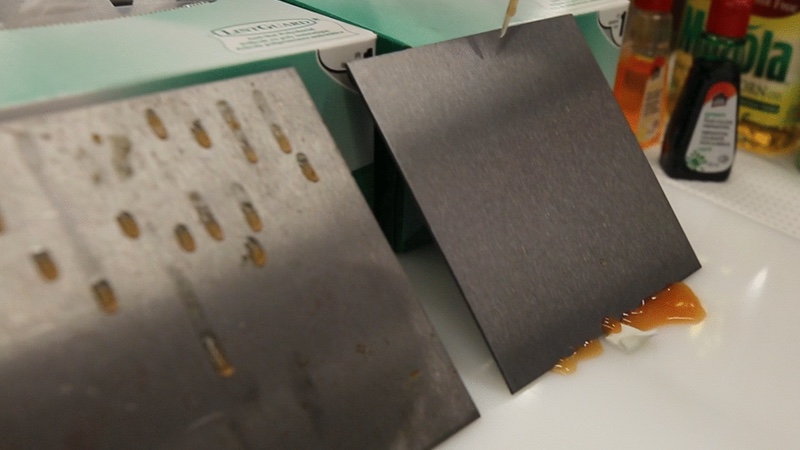Many foods produced on an industrial scale include raw ingredients mixed together in enormous stainless steel machines that can be difficult to clean. With repeated use, equipment surfaces get minute scratches and grooves, providing bacteria and biofilms the perfect place to hide.
While surface scratches may appear small to the naked eye, they are like a canyon to bacteria, which are only a few micrometers in size. Surface-trapped food residue and bacteria then increase the risk of contamination from microorganisms such as Salmonella, Listeria and E. coli.
Professor Ben Hatton, Dr Dalal Asker and Dr Tarek Awad research cheaper, safer and more effective ways to prevent bacteria thriving inside these machines. This minimises the risk of cross contamination, which can lead to foodborne disease. Their team have proposed a simple new solution: trapping a thin layer of cooking oil at the metal surface to fill in microscopic scrapes, cracks and fissures and create a barrier to bacterial attachment.
They found that this solution resulted in a x1000 reduction in bacterial levels inside the industrial machines tested. Their work was recently published in the journal ACS Applied Materials & Interfaces.
“Coating a stainless steel surface with an everyday cooking oil has proven remarkably effective in repelling bacteria,” says Hatton who collaborated on the project with AGRI-NEO, an Ontario seed processing company looking for a solution to a common problem in its industry. “The oil fills in the cracks, creates a hydrophobic layer and acts as a barrier to contaminants on the surface.”

Left, food particles can accumulate on an untreated stainless steel surface, increasing the risk of contamination in food production facilities. Right, the oil-treated surface, repels material. Credit: Liz Do
This simple and cost-effective alternative builds on the slippery liquid-infused porous surfaces (SLIPS) principle, initially developed at Harvard to trap lubricant layers into a surface microstructure and create slippery, non-wetting and non-adhesive properties.
Cooking oils such as olive, corn or canola also provide a safer option for cleaning food-processing equipment than the harsh chemicals and disinfectants that are typically used. The sheer size of the machines makes it harder for cleaning materials to do a thorough job and leftover bacteria can build up resistance to the cleaning agents. Hatton’s method of filling the scratches with oil prevents bacteria from settling and essentially cleans the surface without leaving chemical residues on the stainless steel surface.
“Contamination in food preparation equipment can impact individual health, cause costly product recalls and can still result after chemical-based cleaning occurs,” says Hatton.
“The research showed that using a surface treatment and a cooking oil barrier provides greater coverage and results in 1000 less bacteria roaming around.”
The Hatton research group continues to test new combinations of oils, foods and biofilm types to increase the efficiency of the bacteria barriers. They will also explore options of using this method in developing countries to minimise bacterial infection and improve mortality rates.
